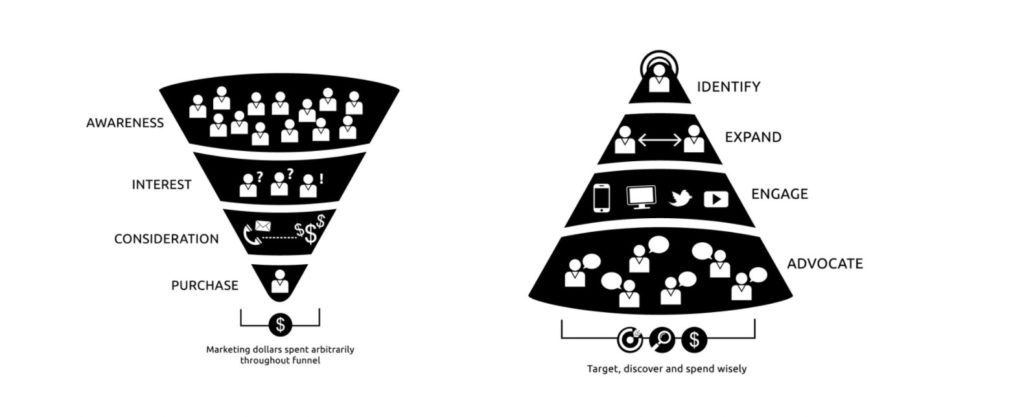Ask 10 people what account-based marketing (ABM) is and you’ll get 10 different answers. Some see it as a sales tactic, while others view it as a content marketing strategy.
Because every business adapts ABM to suit their own growth model, the definition changes to fit.
But, one thing’s for sure: getting clear on what ABM means to your company is critical to making it work. ABM is built on alignment and without everyone on the same page from the start, any plans to drive growth are doomed to fail.
In this article, you’ll learn how to define your ABM strategy so you can target the right accounts and increase your revenue.
Table of contents
What is account-based marketing?
Account-based marketing is an approach where marketing and sales work together to nurture target accounts and convert or retain customers. It’s been defined as “a sustained, coordinated, strategic approach to identifying, engaging, closing, and growing the accounts that we know we should win” by Seismic’s Marketing Director Steve Watt.
In his account-based marketing course, Watt goes on to unpack each of the adjectives in his definition:
- Sustained. ABM isn’t a quick and easy win. It’s not a channel, campaign, or tactic. It’s an ongoing process that takes time to build and grow. Think of it as a filter that helps you find the highest chance of return on investment, revenue potential, and profitability.
- Coordinated. ABM is a team sport. It needs perfect alignment from sales, marketing, and executive leaders across the organization. It’s not an activity that stops at marketing teams delivering leads, nor does it begin with sales. It’s a process that involves every team at every stage.
- Strategic. ABM is “chess, not checkers.” Leaders must think many moves ahead to target the right people with the right content.
- Identifying. By identifying the right accounts, ABM gives you control over who you’re marketing to. Sales finds aligned accounts and works with marketing to create customized journeys.
- Engaging. ABM is a full-court press to build powerful engagement with contacts on the channels that they’re most active.
- Closing. ABM doesn’t stop at lead generation or new opportunities. Sales and marketing collaborate until a deal is closed and beyond to secure long-term customer retention.
- Accounts. Individuals don’t make B2B buying decisions; groups do. ABM must target the entire buying committee, not just one or two individuals who may never be involved in sales conversations.
Account-based marketing flips the traditional marketing and sales funnel upside down.
As Sangram Vajre explains in his book “Account-Based Marketing for Dummies”:
“The traditional lead-based sales and marketing funnel has been turned into a cone by using account-based marketing. The tip of the cone is your initial lead. This lead becomes your first contact and is then developed into an account. That’s how account-based marketing got its name. You’re identifying the accounts you want to engage, then strategically marketing to each contact in the account.”
ABM takes you from fishing with nets to fishing with a spear. It means throwing resources into landing individual accounts, treating them as markets in their own right.
This shift in focus results in more efficient use of your marketing budget, shorter sales cycles, and a better customer experience.
A look at ABM in action: How Snowflake achieved 300% growth in 15 months
Cloud-based data warehouse Snowflake had an ambitious goal to triple its revenue. To achieve this, the company had to shift customer mindset from legacy on-premise deployments to modern data infrastructure. This required more product evangelism and customer wins.
With only 25 salespeople, it also required moving away from “spray-and-pray” demand generation to a more focused ABM.
Marketing and sales worked to define an ideal customer profile (ICP), with several defining factors including:
- Currently using a data warehouse solution;
- Has a defined strategy to move to cloud-based operations;
- Has existing cloud-based solutions from competitor companies.
Marketing development reps were then limited to 100 accounts each and aligned with three to four sales reps to target only 400 accounts.
To ensure buy-in on targeted accounts, Snowflake developed an account intelligence snapshot that provided every stakeholder with an overview of each account and the parameters to evaluate those accounts: Fit, Intent, Relationships, and Engagement (FIRE).
Each salesperson elevated their top 10 accounts to receive highly customized one-to-one account-based marketing programs.
ABM teams then began curating content and tagging it by use case, industry, and persona. Snowflake used content marketing platform Uberflip to curate and tailor content for specific accounts, using a variety of marketing tactics, including ads, email marketing, direct mail, and sponsored content.
To maximize impact and ensure correct prioritization, the team reviewed the top 10 accounts quarterly. Companies outside the top 10 still enjoyed the benefits of account-based marketing, but through engagement-driven one-to-few programs instead.
Within 15 months of switching to ABM, Snowflake achieved over 300% growth and increased click-through rates by 150% on one-to-one ABM ads. The company also added 4X more salespeople to its team and raised $500 million to fund growth and stabilization.
That’s the power of marketing to a chosen few rather than everyone.
Define your ABM strategy to engage profitable accounts
ABM means different things to different companies. How you approach it will depend on your business model and ideal accounts and how (or if) you plan to expand campaigns. However, it will fall into one, two, or three main types.
ITSMA’s ABM framework simplifies these types.
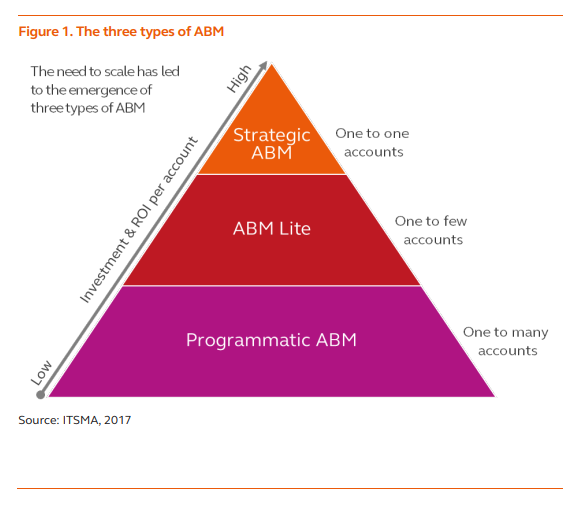
- Strategic ABM: High stakes, highly customized one-to-one marketing typically used to expand existing customer accounts and secure bigger deals. According to ITSMA benchmarks, the typical deal size for Strategic ABM is $2M+, with an average of 14 accounts, and a median spend per account of $36K to $50K.
- ABM Lite: One-to-few accounts marketing, meaning lightly customized programs for clusters of accounts in similar industries or with similar challenges or opportunities. Use this to land new deals and upsell existing relationships. Typical deal size here is $250K+, averaging 50 accounts, with a median spend of $3K to $15K.
- Programmatic ABM: One-to-many accounts marketing that leverages ABM software to tailor and personalize marketing programs for specific named accounts at scale. This is used for landing new accounts that may eventually be used in Strategic ABM or ABM Lite programs. Typical deal sizes for Programmatic ABM are $50K to $250K. The median number of accounts is 725, with an investment per account of $1K to $3K or less.
The median figures for each strategy should give you an idea of which program to lean towards. But there are other factors to consider.
8 questions to ask before developing your ABM program
To know what type of ABM to focus on, you’ll need the answers to some basic questions. Assemble your internal decision-makers and consider:
- What is the size of the deal? The higher the value, the greater the level of customization required to get potential customers on board.
- How complex is your product? The greater the complexity, the more work you’ll need to do to explain it. This will mean greater personalization to understand the customer’s specific goals and pain points.
- How large and complex is the customer organization? Targeting a Fortune 500 is very different from going after a small business.
- How many stakeholders are there? How many people within a company do you need to sway? A small business may only have one decision-maker, but a large organization could have dozens.
- What is the strategic importance of clients? A client may offer more than revenue. For example, securing two or three companies within an industry may give you leverage with the rest of the industry. Because of this, even a small deal may warrant a one-to-one marketing approach.
- How is your company perceived? How well are you known, if at all? What do people think of you? The more brand equity you have, the easier it will be to get customers onside. However, if you need to do a lot of convincing, you’ll need a more strategic plan.
- What is the competitive environment? Who are you up against? Is your industry an open space, or are you up against established industry leaders? Again, the more crowded the market, the more convincing you’ll need to do.
- What is your internal setup? Are you going to be doing this on your own, or do you have a skilled team? Do you have the resources to achieve your objectives?
While you want to set ambitious goals, you don’t want to take on more than you can currently handle. Answering these questions will help you figure out which ABM strategy to start with and evolve to.
With a clearer idea of the strategies and the best approach for you and the client, you can use these fundamentals to craft your strategy.
Do this in three steps.
Step 1: Establish proof of concept with an ABM pilot
There’s no way of knowing whether ABM is right for your accounts until you try it. A pilot program lets you test the waters with existing resources. It’s a chance to learn what you need, develop a scalable system, and measure success to drive future strategies.
Start by defining your objectives: what do you want to get out of ABM?
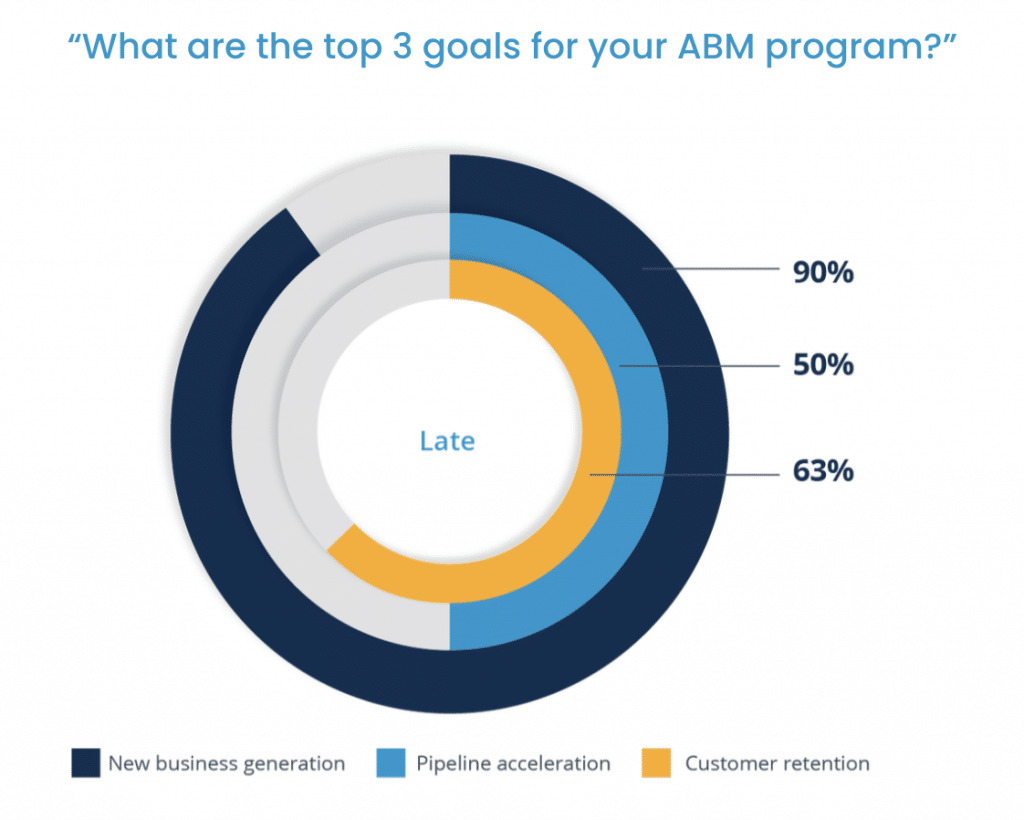
For 90% of companies, the top goal for ABM is new business generation—new clients, new contracts, new logo acquisition, etc.
ABM opens the door to many types of opportunities. Other objectives you might consider include:
- Improving close rate;
- Increasing sales velocity;
- Increase deal size;
- Expanding business with current customers;
- Improving retention;
- Increasing referrals and recommendations.
Get executive buy-in
Once you’re clear on what you want to achieve, secure executive alignment and buy-in by establishing where you are today and where you want to be.
Watt lists some important questions to help you get people on board:
- What is your current market position?
- How quickly are you growing today?
- Are you on a trajectory to meet your mid-term and long-term growth targets?
- Does your company clearly understand current CAC, LTV, CAC payback period, and other core growth metrics?
- Is there a willingness to invest in additional people and programs if you can demonstrate profitable growth through ABM?
- Do you have one or more champions or sponsors on the executive team?
When communicating with the executive team, think about financial goals. How do your plans help the company make more money?
This is ultimately what executives want to know. If ABM makes financial sense, you’re more likely to gain support.
Ensure sales and marketing are on the same page
Sales and marketing alignment is critical to successful ABM. Highly aligned companies grow 19% faster and are 15% more profitable. On the flip-side, those lacking in alignment contribute to an estimated $1 trillion in lost revenue every year.
What’s the current relationship between your marketing and sales teams?
Do they get along? Do they plan together and share data?
If your company isn’t properly aligned, work on opening channels of communication and data sharing.
Crossbeam, for example, gives its teams access to a company-wide Slack channel:
“Everyone at Crossbeam has access to dashboards that update in real-time with our progress toward these key results, and our progress also auto-posts to Slack each morning to keep people in the loop and drive discussions around progress. This keeps the company on the same page and aligned on what matters most.” – Robert Moore, CEO at Crossbeam [via Hubspot]
Blueleadz maintains alignment with a shared ecosystem:
“We collaboratively create processes that we share and refine together. For example, marketing will help us create sales content, and our sales team refines those content assets over time and shares the results. This ongoing communication about what’s working and what is not working is vital. We maintain an open communication channel by meeting every week to address friction points, establish action items, and hold each other accountable.” – Dave Stout, Inbound Specialist at Blueleadz [via Hubspot]
Sales shouldn’t feel like they’re helping out marketing, and marketing shouldn’t feel that they’re passing leads on for sales to take the glory. Both departments co-own ABM.
Make sales leaders part of your ABM leadership team. Champion collaboration throughout your pilot. This will help turn them into advocates who are happy to sing the praises of ABM to their colleagues.
Planning your pilot
The idea of a pilot is to build trust with stakeholders and maximize learning while minimizing risk.
Your pilot should be big enough to get results and have something to measure but small enough not to be damaging if it doesn’t work out. Your pilot might be inefficient, or it might even fail—but that’s how you learn and get closer to the winning strategy.
Be clear on your objectives and what success looks like. For example, if one new acquisition is worth $10K, a pilot win could be 20 new acquisitions for $200K.
Base your success rate on your current inbound close rates. If that rate is 5%, you would need to target 400 accounts.
Keep your targets realistic and achievable within your budget and team. If you’re going to run it with a team of two, creating content to engage and interact with 400 accounts may be a stretch too far. Or, it may require you to invest in tools or extend the length of the pilot. If you have a dedicated ABM team of six or more then you have more flexibility.
Step 2: Hone in on your ideal account
Your pilot plan gives you an idea of how many accounts to go after; now, you need to put names to it.
To hit the mark, ABM has to target the right accounts. These accounts are a combination of marketing and sales data and require complete alignment from both teams.
Your ideal account profile may closely match the ideal customer profile that you use to engage customers with marketing and sales collateral. Use this, along with CRM data, as building blocks to filter and find target accounts.
Here are three approaches you can take to hone your ideal account:
Fit, intent, and engagement
Finding a pool of accounts that are a good “fit” for ABM teams to work on can be done using firmographics and demographics from your marketing and CRM data. Look for:
- Industries and regions where you have strong penetration;
- Your sweet spot in terms of target company size;
- Any stacks your product or solution integrates best with.
Use intent to add an extra layer to this data by researching information or triggers that signal a target account is interested in your product.
Paid tools can help you figure out what people are searching for, which we’ll list later. But you can get started for free by setting up Google Alerts for certain topics related to your account.
You can also use LinkedIn to monitor specific hires and departures, and examine company publications for updates that may show intent.
Finally, look at how accounts showing intent engage with your business:
- Who is visiting your website?
- Who is following you on social media?
- Which are interacting with you at trade shows?
Combine these findings, and you’ll have a solid idea of which accounts are most likely to benefit from ABM.
Predictive, intent, behavioral, and trigger
This method is a tech-heavy approach better suited to large organizations with tens or hundreds of thousands of accounts and the resources to invest in multiple tools.
By looking at your accounts through four lenses, you can clarify high-quality accounts to prioritize.

- Predictive: Use predictive marketing software to unearth relevant target accounts based on different aspects of your current customer base, such as firmographics and demographics.
- Intent: Use intent data to figure out which organizations are trying to solve problems that your product can help with.
- Behavioral: Dig into your analytics to find who’s engaging with your website and social media accounts.
- Trigger: Use a contact database to find out where organizations are at in their development (e.g., who’s adding new products or expanding into new areas).
Gates and weights
The gates and weights method is a cards-on-the-table approach. It looks at the different aspects of a target account that may have impact, then breaks them down into phases.
Phase one looks at a bunch of factors: technographic and firmographic data, behavior and intent, organization structure, company prestige, culture, market position, likelihood to grow, agency usage, and opportunity to do great work.
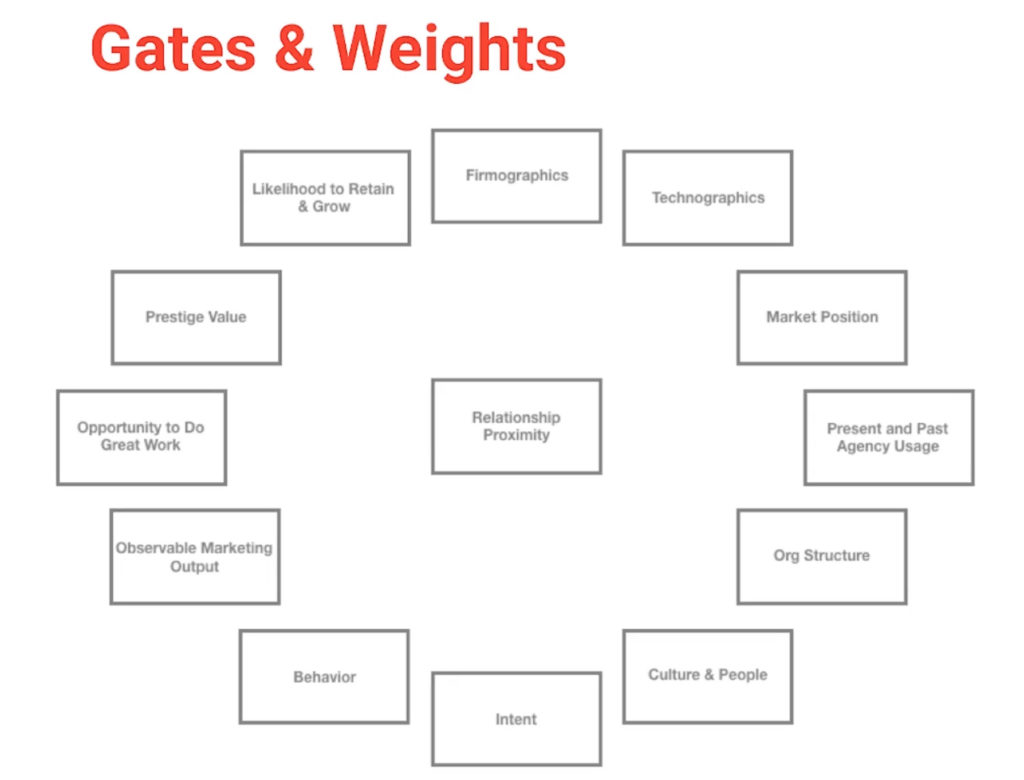
Phase two groups these factors into categories.
- About the company: firmographics, organizational structure, market position, etc.;
- Perceptions of the company: prestige value, culture and people, likelihood to retain and grow, etc.;
- What the company is doing: observable market output, intent, behavior;
- Your path to the company: your relationship proximity.
Phase three takes the most important factors from phase two to build an ideal account profile. It goes into more detail, such as how likely they are to be a market leader and which technologies they’re using.
Phase four takes organizations that match the ideal account profile and passes them through different gates.
For example, if you’re targeting a company with $5 million in annual revenue, does an organization on your ideal account list meet those criteria? If so, they make it to the next gate, which could be: do they have a marketing operations team? If not, they drop out.
By the end of the process, you’re left with a small number of key accounts to focus on.
Step 3: Analyze your audience to build strong connections
Once you know who you’re talking to, you need to figure out what to say. The most pinpointed targeting won’t matter if you can’t deliver content that meets an account’s priorities and pain points.
How much research you’ll need to do into your target accounts depends on your ABM strategy.
If you’re using Programmatic ABM to target hundreds of accounts through marketing automation, tap into your buyer personas. But do so in a way that dials into their priorities.
Use some of the information research for strategic one-to-one ABM, or small clusters of one-to-few ABM to do this.
The fewer people you’re marketing to, the more important it is to understand them intimately. For Strategic ABM, personas don’t matter. What matters is the individual.
Here are some questions to answer in your research:
- What are the account’s top business priorities this year, next year, and in the next three years?
- How do they match up to the competition?
- What are their strengths and weaknesses?
- What tools do they use, and where do you fit into these?
- How is the company structured?
- Who are the key stakeholders and influencers?
- Who reports to whom?
- What are they saying in the media or at conferences?
- Are there key roles the company is looking to fill?
Find ways to connect with who you’re talking to:
- Read company blog posts;
- Listen to podcasts and conference talks;
- Look at previous presentations;
- Read job sites to find out the number of roles and job titles and how these are described;
- Follow and interact with companies and stakeholders on social media;
- Look at things you have in common (e.g., mutual connections, education, places you’ve lived or visited).
Use everything you can find about stakeholders to form genuine bonds with the right people. These are what ultimately will move deals forward.
Where are your accounts, and where are you taking them?
ABM is different from inbound marketing in that your target audience hasn’t put their hand up for anything. They haven’t completed a form, joined a webinar, or requested a demo.
You know from the research you’ve done that they will. But you first have to engage them.
Think of the buyer’s journey as “the account is here, and it needs to get there.”
For example, an account may have never heard of you. In the short term, your task is to get noticed and considered by key stakeholders. In the long term, you might move from being a vendor for the account into a partner and advisor.
The customer journey is not a single asset that will get people on board; it’s a series of events that take accounts on a long-term journey. As Watt puts it: “think in terms of plays, not silver bullets.”
Once you understand your accounts and the journeys you need to take them on, you can pick the best traditional and digital marketing channels, for example:
- Social media;
- Search engine marketing;
- Email marketing;
- PPC advertising;
- Whitepapers;
- Podcasts;
- Webinars and video content;
- Customized website experiences;
- Gifting;
- Trade shows;
- Direct mail;
- Phone calls or text messaging.
Test different channels. Experiment with different follow-ups. Measure success by how each contributes to the goal of getting the win.
ABM tools of the trade to power for marketing efforts
As you scale up your account-based marketing strategy, tools will be important in helping you unearth accounts and power ABM campaigns. But you should only consider them after you’ve laid the foundations and have an ABM strategy in place.
“If something is painful, if something’s important, you know it’s important, but it’s really hard to do, that’s where some of these great ABM tools come in.” – Watt
Tools for finding accounts to focus on:
Tools for finding accounts to focus on and honing messaging:
Tools for website personalization:
Tools for enhanced content delivery:
Tools for sending physical assets:
Tools for IP-targeted ads:
Tools for customized videos:
Tools for measuring ABM impact:
Forrester’s ABM Vendor Review maps the top-performing tools in current offering, strategy, and market presence:
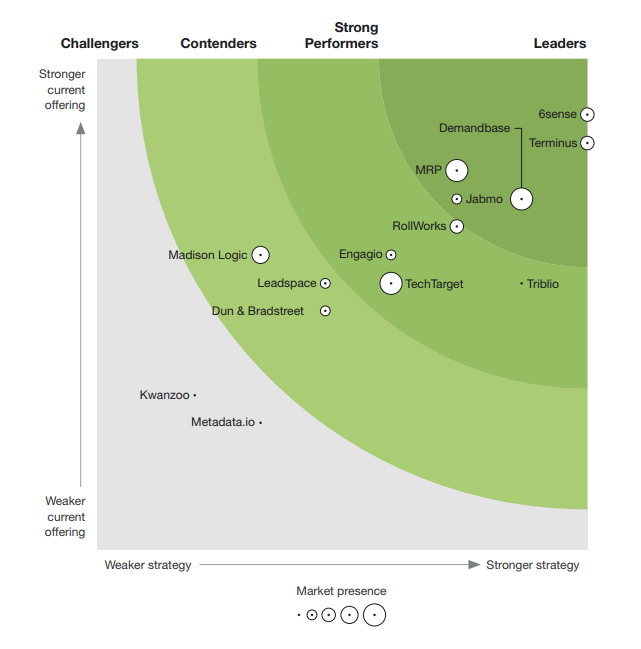
It also summarizes the strengths and weaknesses of each platform:
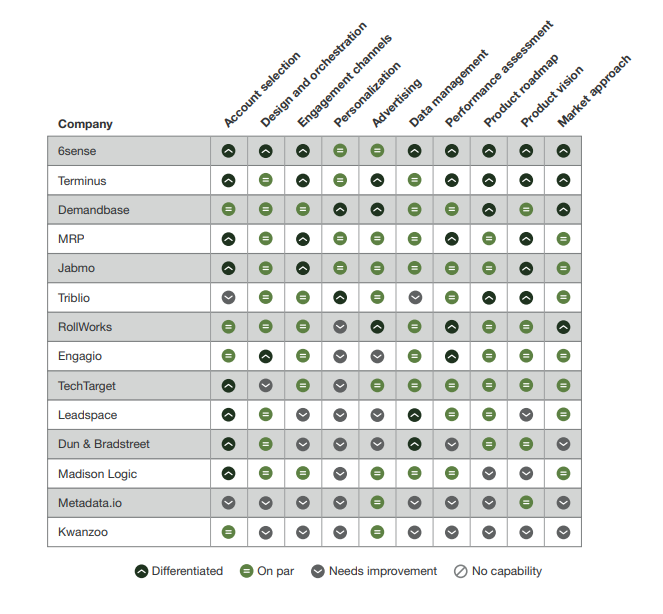
Use this to compare tools based on your needs and research solutions that benefit your current initiatives.
Conclusion
Account-based marketing isn’t like other marketing strategies. It’s not a campaign you can run for a short-time to drive demand and show results in 30 to 60 days. The horizon is much further in the distance, led by insights and customer-centric engagement where the best opportunities aren’t always clear from the start.
Success starts with a united front. Position ABM correctly from the get-go. Clearly define what ABM means to your company. Ensure all stakeholders know that this is a long-term, company-wide relationship-building program.
The most significant financial returns will happen in the later stages, after you’ve identified and engaged target accounts. But with everyone aligned, you can set realistic expectations and use interim successes such as improving reputation, engagement, and relationships to secure internal support and keep ABM efforts funded.
Master the skills you need to excel at account-based marketing in CXL’s Account-based Marketing course.

